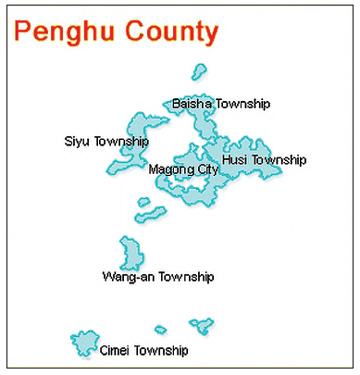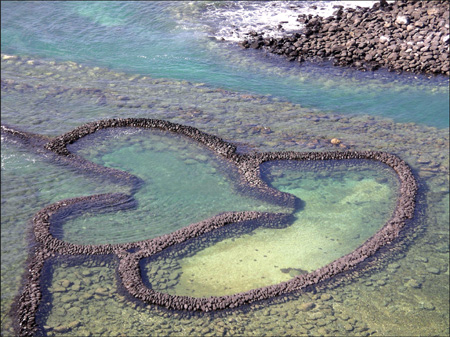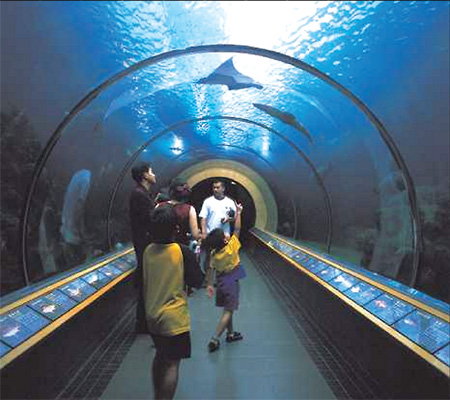Sea sites and sights
Updated: 2010-01-16 07:35
(HK Edition)
|
|||||||
|
Honeymoon Bay at Qimei, the southern-most of the Penghu Islands, and a map of Penghu County. |
Known for its exquisite beaches and rich coral beds, the Penghu Archipelago is one of the centers of Taiwan's marine-driven culture. But as we learn in this report there's much more than can be learned about marine life, even in the "off season"
As an island enveloped by large bodies of water, Taiwan naturally comes with a culture that features aspects related to the sea, marine life, beach culture, even bridge building.
A 50-minute flight from Taipei brings one to Baisha Township, on the northern part of the main, most populous island of Makong in Penghu County, geographically known as the Penghu Archipelago (Islands). The town is a focal point of Taiwan's aquatic culture.
The name of the township, Baisha, means "white sand" in Chinese and derives from the white beaches running several kilometers along the island's north and east coast.
Offshore from Baisha Township is Little Baisha Island, whose surrounding waters house extensive coral reefs. The place is famous, and considered a paradise for sunbathing, swimming and snorkeling.

Even though most people visit the area for its beautiful, soft white sand and bright sunny weather (the tourist season tends to be between April and August), Penghu possesses much more than that for visitors all year round.
The first site in town, that's not to be missed, is the Penghu Aquarium, proves the point.
Set up by the Fisheries Research Institute, Penghu Aquarium was opened to the public in 1997, occupying 2.5 hectares. The area of the neat two-storey building adds up to approximately 4,600 square meters, capable of admitting up to 500 people at a time.
The aquarium is divided into three exhibition zones, each with a theme in the order of seashore, coral reefs, and the ocean - leading visitors from the shallow to the deep.
All aquatic creatures in the aquarium originated from the waters in an 800km radius of Baisha town, including the Taiwan Straits and South China Sea. The exhibits reflect the varied marine world of the Penghu region.
Not far past the entrance to the aquarium, visitors come to the Reef Tank, where three green sea turtles glide in graceful circles. They are not far removed from the old sea turtles that appeared on screen in Pixar's Finding Nemo.
Note: Feeding is strictly prohibited (even if you sincerely believe they're asking for food).
Several tanks display different live corals up close. Visitors are fascinated by the wide range of life around the Penghu Islands as exemplified by the display tanks.
The writer's favorite part of the delightful aquarium is the underwater glass tunnel 2.8m in diameter and 14m long. Built under the big Ocean Tank, the tunnel provides visitors with a 180-degree view. It lends one the impression of walking alongside the underwater creatures - the writer jumped when a guitarfish swam by.
Other local animals living in the Ocean Tank include salt-water fish and some shark species. Feeding shows take place in the big fish tank and are available for public viewing twice a day, at 11 am and 3 pm.
Note: Feeding session times are subject to change, depending on the season and water temperature.
Once through the glass tunnel, visitors arrive at a corner of the aquarium with long benches facing the other side of the Ocean Tank. It's perhaps the most calming spot in the building.
Rare ocean creatures and displays on the second floor bring to light marine conservation issues, such as over-fishing and ocean ecology. A touch pool, designed for children, allows visitors to feel some sea creatures, such as the starfish.
The open space outside the building is creatively designed with beautiful gardens and gigantic eye-catching statues of various sea animals, including a huge shark's jaw and some amiable-looking dolphins. A children's playground lightens the atmosphere while a few big sculptures of lobsters and crabs ornament the parking lot.
Even though the aquarium is not Taiwan's biggest, the assortment of marine life there makes up for its small size.
The aquarium is open from 9 am to 5 pm daily. Admission is NT$200 for adults, NT$150 for students, and free for children under 110 centimeters tall.
A never-ending bridge?
Over the water, connecting the islands of Baisha and Siyu is Penghu's cross-sea bridge. Locals often refer to it as "the Great Bridge", for its combination of magnificent form and function.
Not only does the bridge make one of the prettiest Penghu islands accessible, the 2.5-kilometer span is also one of the longest sea bridges in East Asia.
The bridge crosses the Houmen Channel, which the locals consider dangerous due to its depth and rapid currents; many ships went down in the treacherous channel before the bridge was built.
At the entrance of the bridge sits a graceful arch that holds symbolic meaning.
The view of the ocean seen from the bridge has earned such accolades as "overwhelming" and "amazing" from many a visitor.
It also boasts the lookout for the most romantic sunset. Watching the golden sky merging with the dark blue sea is breathtaking.
As night comes, lights of various purposes turn the bridge into a band of stars that reminds people immediately of the Milky Way.
Note: It gets very windy here at night (even in summer), so a light jacket is strongly recommended.
The next stop is back on land in an old village in Baisha Township.
Tongliang Village, situated south of the town, is a 5-minute drive from the Great Bridge. The village is a popular destination because of Bao An Temple, but even more so because of the 300-year-old Great Banyan located in front of the temple.
The Great Banyan's 90 some aerial roots have, over time, penetrated the ground and grown into many trunks, covering approximately 660 square meters. Visitors often mistake the place for a miniature forest with dozens of trees. Standing in the garden, a visitor feels it is like being under a massive green umbrella, which keeps one in the shade and shelter from the strong wind.
This giant tree is the largest and oldest in Penghu County. Locals apparently began to respect the temple a lot more because they believed the gods made the Banyan strong, healthy, and long lasting. The magnificent tree adds value to Penghu County, making it another good reason to visit the dynamic Baisha Township.
How to get there:
By air - Flights are available from Taipei, Taichung, Tainan, Chiayi and Kaohsiung. A round-trip ticket for the 50-minute journey is approximately NT$3,200 per person from Taipei.
By sea - Four-hour ship rides are available from Chiayi and Kaohsiung. A return journey costs about NT$1,500 from Kaohsiung.
China Daily/ANN
|
The glass underwater tunnel in the Penghu Aquarium. File photos |
(HK Edition 01/16/2010 page4)

